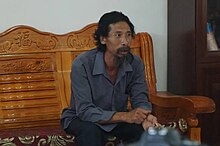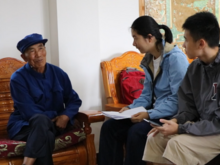Draft:Dumb Festival
 Comment: The article lacks any major sources that can establish notability. The sources themselves seem to be blogs or personal websites, except for one which comes from the local government. The prose itself is poorly sourced otherwise. The images are possibly copyright violations looking at the sources and might need to be looked into. NyanThousand (talk) 16:29, 8 August 2024 (UTC)
Comment: The article lacks any major sources that can establish notability. The sources themselves seem to be blogs or personal websites, except for one which comes from the local government. The prose itself is poorly sourced otherwise. The images are possibly copyright violations looking at the sources and might need to be looked into. NyanThousand (talk) 16:29, 8 August 2024 (UTC)
The Dumb Festival (Simplified Chinese: 哑巴节, Pinyin: yabajie) is a traditional festival of the Yi people of China that takes place on the eighth day of the first month of the Chinese calendar, usually corresponding to February in the Gregorian calendar. The festival is celebrated at multiple sites, the most notable of which is in Qixuan Village in Western Yunnan. The festival involves a day of the village's totem, portrayed by the Big Dumb and overseen by the Big Bimo, dancing from the village temple to the villagers' houses to dispel illness and misfortune for the year. The Big Dumb is accompanied by Middle Dumbs and Small Dumbs, all of whom wear traditional apparel and face paint.

In 2009, the Dumb Festival was designated as an Intangible Cultural Heritage by the Yunnan province. Thanks to growing popularity, the festival attracted upwards of 100,000 tourists before COVID-19.
Origin
The Dumb Festival is held to commemorate a fictional Qixuan woman who wasn't able to speak. Local legends have it that a plague erupted in Qixuan, killing many people and leaving those who survived helpless. Most of the remaining population became disabled or mute, and could only drift around to beg for a living. After several years, a beautiful young girl, muted during the plague, refused to see the village declining like this and resolutely decided to go out and seek medical treatment for everyone.
Years passed as she visited many doctors, but the illnesses showed no signs of improvement, leaving her deeply anxious. One day, a handsome young man suddenly arrived in the village. He fell in love with the mute girl at first sight. He told her that he liked her, and if she agreed to marry him, he would cure all the illnesses in the village and bring prosperity. The mute girl, skeptical, publicly stated that if he could fulfill his promise, she would marry him.
The young man was overjoyed and had the villagers set up a stove. He took them to the mountain to find herbs and brewed a potion for everyone to drink. After three days of drinking this large pot of medicine, a miracle occurred—the people's illnesses were cured, and the mute could speak. Everyone rejoiced, celebrating with singing and dancing.
When the people calmed down and wanted to thank their benefactors, they found that both the mute girl and the young man were gone. Later, many elders in the village had the same dream: the mute girl and the young man were having their wedding in the Dragon Palace, and Guanyin Bodhisattva presided over the ceremony. The groom turned out to be the third son of the Dragon King. The young girl left on the eighth day of the lunar new year, and she'd visit the village every year on the same day with her sons. To commemorate her generosity, the villagers celebrated her kindness and blessed for health and prosperity on the same day each year..[1][2]
Participants
Big Dumb

The Big Dumb (Simplified Chinese: 大哑巴, Pinyin: dayaba) leads the festival. Said to have the ability to "tear a house down with a scream", the Big Dumb starts the Dumb Festival from the village temple, is carried down the mountain by the Middle Dumbs on a sedan chair, and is joined by the Small Dumbs and invited to the villagers' houses. In the houses, they perform the Dumb Dance, said to bless prosperity in the household. The Big Dumb finishes the festival by dancing around a campfire in the village's central square.[3]

The Big Dumb is typically portrayed by a local male villager and is selected by the preceding Big Dumb. They usually inherit the role in their twenties and retire in their sixties. The current Big Dumb is played by Jinquan Luo[4], who took the role when he was 23 in 1999 and was the 15th Big Dumb[5]
Middle Dumbs

The Middle Dumbs (Simplified Chinese: 中哑巴, Pinyin: zhongyaba) accompany the Big Dumb throughout the festival and are responsible for carrying the Big Dumb's sedan chair, performing the Dumb Dance, and covering the village roads with pine needles. Middle Dumbs are typically portrayed by twelve prestigious men in the village. Qixuan Village's leader, Tianming Luo, currently leads the group of Middle Dumbs.
Small Dumbs
The Small Dumbs (Simplified Chinese: 小哑巴, Pinyin: xiaoyaba) are children villagers that join the Big Dumb and the Middle Dumbs in the Dumb Dance. They're viewed as fortune givers and greatly valued in the festival. All children in the village participate in the festival by portraying Small Dumbs.
Big Bimo

The Big Bimo (Simplified Chinese: 大毕摩, Pinyin: dabimo) is a local master of Bimoism, the indigenous religion of the Yi people. The Middle Dumbs travel to the Big Bimo's house every year to invite him to oversee the festival. The Big Bimo is currently Jianxuan Luo.
Recognition and Awards
The Dumb Festival and Dumb Dance have won several provincial awards:
- Intangible Cultural Heritage (2009)
- Dali "March Street" Cultural Festival: Silver Award
- Yunnan Cultural Performance: Gold Award (2011)
The core participant, namely Jinquan Luo (portraying Big Dumb), has earned some personal recognitions:
- Prefectural Intangible Cultural Heritage Heir (2013)
- Provincial Intangible Cultural Heritage Heir (2014)
- Painted Big Dumb Mask Set (of six masks) collected by Yunnan Cultural Museum (2015)
References
- ^ China Minority Religions Net. "一个古老而神奇的节日:大理七宣彝族哑巴节".[dead link]
- ^ Dali Bai Autonomous Prefecture People's Government (July 10, 2023). "祥云哑巴节".
- ^ "【新春走基层】新春看"村晚" 祥云哑巴节". Feb 20, 2024.
- ^ Beauty of Nostalgia NPO (Aug 10, 2021). "创造"营",创造"家" | 大营文化创变营回顾".
- ^ Dali Daily News (May 11, 2017). "【视觉】"哑神"罗金全". Sohu.
